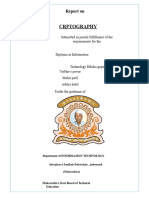**Unlocking the Secrets of Cryptography: Your Guide to Secure Communication**
In the age of digital communication, the security of our data and messages is of paramount
importance. Whether you're texting a friend, making an online purchase, or sending sensitive
information, cryptography is the invisible guardian that ensures your information remains
confidential and secure. Let's dive into the fascinating world of cryptography and understand how it
works.
**What is Cryptography?**
Cryptography is the science of securing information by transforming it into an unreadable format,
known as ciphertext, using various algorithms and mathematical techniques. This process is achieved
through encryption, and the inverse operation, decryption, is used to convert the ciphertext back
into its original, readable form, known as plaintext.
**The Pillars of Cryptography:**
1. **Confidentiality:** Cryptography ensures that unauthorized individuals cannot access or
understand the content of your messages or data.
2. **Integrity:** Cryptographic methods can detect whether your information has been tampered
with during transmission. Even the slightest change to the data will be detected.
3. **Authentication:** Cryptography is used to verify the identity of the sender and receiver,
preventing impersonation or unauthorized access.
4. **Non-Repudiation:** It prevents senders from denying their involvement in a message or
transaction.
**Types of Cryptography:**
1. **Symmetric Key Cryptography:** In this type, the same key is used for both encryption and
decryption. While it's efficient, securely distributing the key to both parties can be a challenge.
�2. **Asymmetric Key Cryptography:** Also known as public-key cryptography, it uses a pair of keys –
a public key for encryption and a private key for decryption. This method simplifies key distribution
and enhances security.
**Everyday Applications of Cryptography:**
1. **Secure Online Transactions:** Cryptography ensures the confidentiality and integrity of online
financial transactions, protecting your sensitive information from theft.
2. **Email Encryption:** Services like PGP (Pretty Good Privacy) and S/MIME use cryptography to
encrypt emails, safeguarding your communications from prying eyes.
3. **Secure Messaging Apps:** Messaging apps like WhatsApp and Signal employ end-to-end
encryption to prevent unauthorized access to your conversations.
4. **Secure Browsing:** HTTPS (Hypertext Transfer Protocol Secure) encrypts data between your
browser and websites, preventing eavesdropping and data manipulation.
**The Future of Cryptography:**
As technology advances, the field of cryptography continues to evolve. Quantum computing, for
instance, presents both a challenge and an opportunity for cryptography. While it has the potential
to crack some encryption methods, it also inspires the development of quantum-resistant
cryptographic algorithms.
**Becoming a Cryptography Enthusiast:**
1. **Learn the Basics:** Start with the fundamentals of cryptography, including encryption
algorithms, key management, and cryptographic protocols.
2. **Explore Cryptographic Tools:** Experiment with encryption tools and software to gain hands-on
experience.
3. **Stay Updated:** Follow developments in the field, as new cryptographic techniques and threats
emerge regularly.
�4. **Ethical Hacking:** If you're interested in cybersecurity, understanding cryptography is essential
for roles like ethical hacking and penetration testing.
In conclusion, cryptography is the silent guardian that protects our digital world. By understanding
its principles and applications, you can navigate the digital landscape with confidence, knowing that
your data and communications are shielded from prying eyes. Cryptography is not just a science; it's
a safeguard for the modern age.






















































































